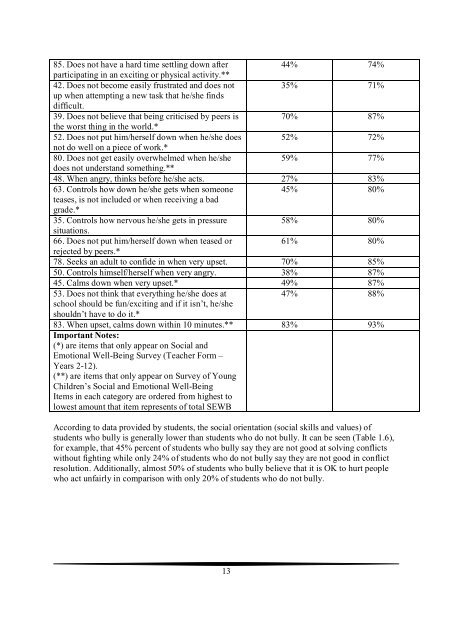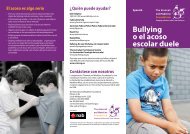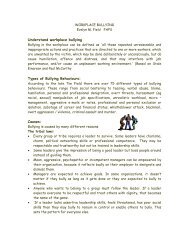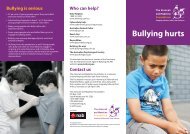The social and emotional wellbeing of students who bully different ...
The social and emotional wellbeing of students who bully different ...
The social and emotional wellbeing of students who bully different ...
You also want an ePaper? Increase the reach of your titles
YUMPU automatically turns print PDFs into web optimized ePapers that Google loves.
85. Does not have a hard time settling down after44% 74%participating in an exciting or physical activity.**42. Does not become easily frustrated <strong>and</strong> does not35% 71%up when attempting a new task that he/she findsdifficult.39. Does not believe that being criticised by peers is 70% 87%the worst thing in the world.*52. Does not put him/herself down when he/she does 52% 72%not do well on a piece <strong>of</strong> work.*80. Does not get easily overwhelmed when he/she59% 77%does not underst<strong>and</strong> something.**48. When angry, thinks before he/she acts. 27% 83%63. Controls how down he/she gets when someone45% 80%teases, is not included or when receiving a badgrade.*35. Controls how nervous he/she gets in pressure58% 80%situations.66. Does not put him/herself down when teased or61% 80%rejected by peers.*78. Seeks an adult to confide in when very upset. 70% 85%50. Controls himself/herself when very angry. 38% 87%45. Calms down when very upset.* 49% 87%53. Does not think that everything he/she does at47% 88%school should be fun/exciting <strong>and</strong> if it isn’t, he/sheshouldn’t have to do it.*83. When upset, calms down within 10 minutes.** 83% 93%Important Notes:(*) are items that only appear on Social <strong>and</strong>Emotional Well-Being Survey (Teacher Form –Years 2-12).(**) are items that only appear on Survey <strong>of</strong> YoungChildren’s Social <strong>and</strong> Emotional Well-BeingItems in each category are ordered from highest tolowest amount that item represents <strong>of</strong> total SEWBAccording to data provided by <strong>students</strong>, the <strong>social</strong> orientation (<strong>social</strong> skills <strong>and</strong> values) <strong>of</strong><strong>students</strong> <strong>who</strong> <strong>bully</strong> is generally lower than <strong>students</strong> <strong>who</strong> do not <strong>bully</strong>. It can be seen (Table 1.6),for example, that 45% percent <strong>of</strong> <strong>students</strong> <strong>who</strong> <strong>bully</strong> say they are not good at solving conflictswithout fighting while only 24% <strong>of</strong> <strong>students</strong> <strong>who</strong> do not <strong>bully</strong> say they are not good in conflictresolution. Additionally, almost 50% <strong>of</strong> <strong>students</strong> <strong>who</strong> <strong>bully</strong> believe that it is OK to hurt people<strong>who</strong> act unfairly in comparison with only 20% <strong>of</strong> <strong>students</strong> <strong>who</strong> do not <strong>bully</strong>.13









